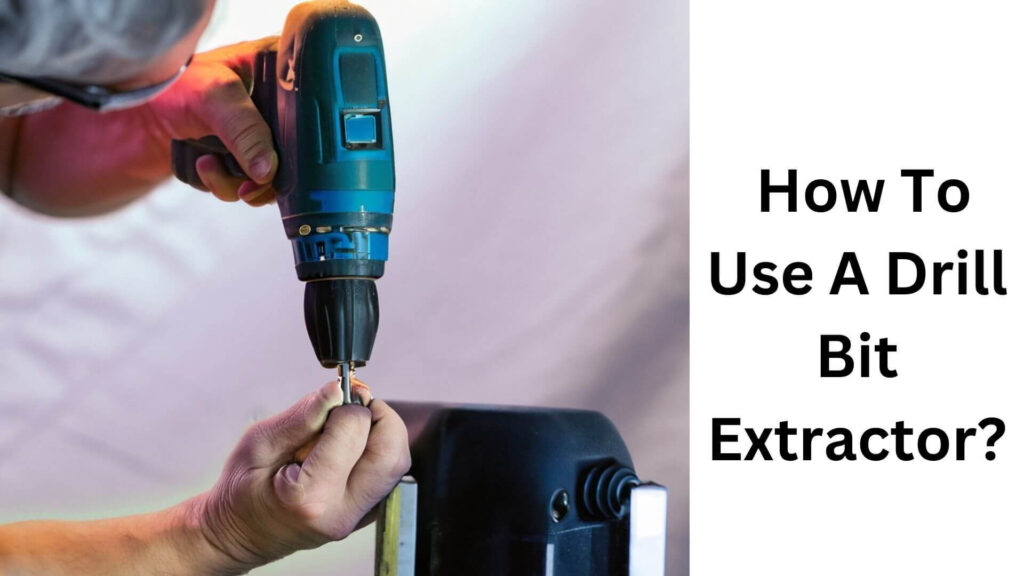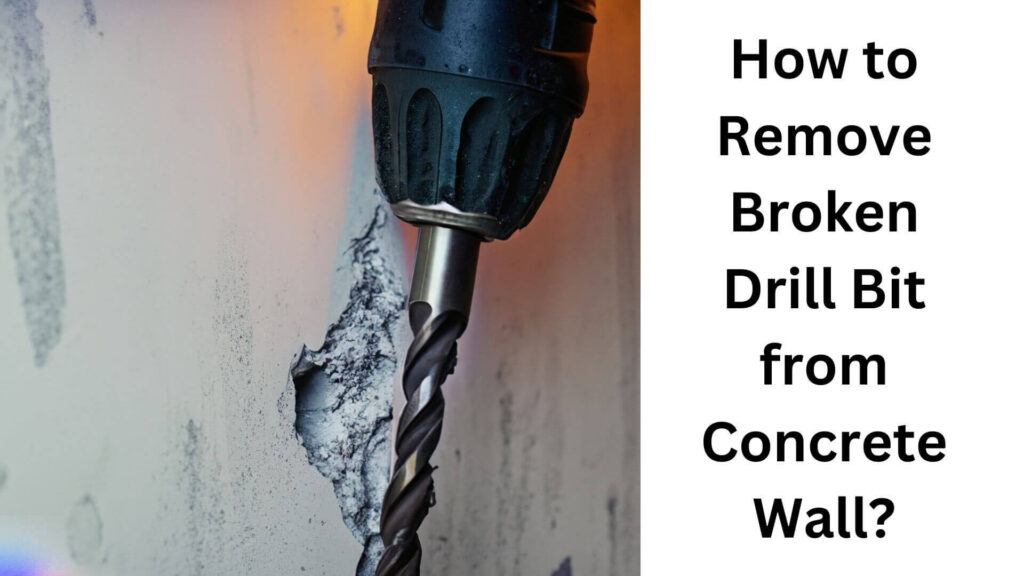Removing a broken drill bit from a concrete wall requires careful drilling and extraction techniques. First, drill around the broken bit with a carbide drill bit in reverse mode to create a wider opening.
Then, use a screw extractor to remove the broken bit by placing it in the drilled hole and turning it counterclockwise.
Be patient when removing the broken drill bit to avoid causing further damage to the wall or injuring yourself.
Drilling into concrete walls can be challenging, and sometimes accidents happen, breaking the drill bit. Unfortunately, the broken drill bit poses a significant problem that needs fixing.
Attempting to remove the drill bit by force can cause severe damage to both the wall and the tool. Therefore, knowing how to remove a broken drill bit from a concrete wall effectively is essential.
This article will guide you through the steps required to ensure you can remove the broken drill bit without causing more damage to your project.
Table of Contents
The Right Tools
The right tools are essential when removing a broken drill bit from a concrete wall. Here are some of the critical tools you’ll need for the removal process:
- Safety glasses: Protect your eyes from flying debris while drilling.
- Gloves: Prevent injuries and provide a better grip on the tools.
- Drill bit extractor: A specialized tool designed explicitly for removing broken drill bits from concrete walls.
Choosing The Right Extractor
Choosing a suitable extractor is crucial for the success of the removal process. Here are a few things to keep in mind when purchasing an extractor:
- Size compatibility: The extractor size should match the broken drill bit’s size for effective extraction.
- Durability: The extractor should have durable materials to prevent breakage during extraction.
- Ease of use: Choose an extractor that is easy to use and comes with clear instructions on how to use it effectively.
Having the right tools and choosing the suitable extractor can make all the difference in safely and successfully removing a broken drill bit from a concrete wall.
Always wear safety glasses and gloves when performing any drilling work, and choose the extractor that fits your needs and budget.
Check Also: The Top 8 Concrete and Rebar Drill Bits for Your Projects
Preparing For Removal
● Tips For Preparation
Before attempting to remove a broken drill bit from a concrete wall, it is essential to prepare for the job. Follow these tips to ensure a more effective and safe removal process:
Clean the area around the broken drill bit thoroughly. Remove any dust or debris using a stiff-bristled brush or vacuum cleaner.
Mark the drill bit’s position on the wall to ensure that you remove the correct section and avoid damaging the surrounding area.
● Proper Drilling Techniques
To remove a broken drill bit from a concrete wall successfully, it is necessary to use proper drilling techniques. Follow these guidelines:
Use a hammer drill to create a hole around the broken drill bit. A hammer drill is more effective than a regular drill and will reduce the risk of damaging the wall.
Use a slow drilling speed to prevent further damage to the wall and improve the accuracy of the hole.
Once the hole is complete, use a pair of pliers or vice grips to remove the broken drill bit from the wall.
Using these techniques and tips, you can safely and effectively remove a broken drill bit from a concrete wall. Remember to take your time and pay attention to detail throughout the process.
How To Use A Drill Bit Extractor?

Instructions On How To Use The Drill Bit Extractor, Including Step-By-Step Guidelines:
- Removing a broken drill bit from a concrete wall could be daunting, especially when you don’t have the right tools for the job. For example, a drill bit extractor could be your best bet in such a situation. Here are some essential guidelines to consider when using a drill bit extractor:
- Start by equipping yourself with proper safety gear. Wear gloves, goggles, and a dust mask to protect yourself from dust, flying debris, or possible injuries.
- Mark the center of the broken drill bit using a center punch. This helps to guide the extractor into the correct position.
- Choose the appropriate size of an extractor for your drill bit. Insert the extractor into the drill and ensure that it fits firmly.
- Place the drill at a right angle to the wall and slowly start drilling toward the broken bit. Apply firm and even pressure.
- Stop drilling once the extractor has fully penetrated the drill bit. Rest for a few seconds before reversing the drill in the opposite direction.
- Apply steady pressure to remove the broken drill bit while turning the extractor clockwise. If the extractor seems to slip or doesn’t move, stop the drill, back it out, and try a different approach.
The Importance Of Taking Extra Precautions When Using An Extractor To Avoid Further Damage To The Wall
While using an extractor can help remove a broken drill bit, it’s essential to take extra precautions to avoid causing further damage to the concrete wall. The following tips could help:
- Avoid using excessive force when drilling into the wall, as it could cause the bit to wander and create unwanted holes or cracks.
- Use a low-to-medium speed setting on your drill to prevent overheating or damaging the wall.
- Once you’ve removed the broken drill bit, use an appropriate anchoring method to secure the new fixture or drilling point to the wall.
- Dispose of the broken drill bit and debris safely to avoid injury, environmental damage, or legal issues.
By adhering to these tips, you can use a drill bit extractor to successfully remove a broken drill bit from a concrete wall.
Remember to put on proper safety gear, choose the appropriate size of an extractor, and take extra precautionary measures to avoid causing further damage.
Read More: The Vibrant Hue of a Concrete Drill Bit: Unveiling its True Color
Alternative Techniques
If you need to remove a broken drill bit from a concrete wall, you may have tried using a drill bit extractor to no avail. But don’t worry; alternative techniques could help you remove the broken drill bit.
This blog post will discuss these alternative techniques and when to seek professional help.
Mention Alternative Techniques If The Use Of A Drill Bit Extractor Does Not Work
If a drill bit extractor doesn’t work, there are alternative techniques that you can try. These include using a screwdriver, pliers, or a hammer and chisel.
Pros And Cons Of Alternative Methods
Before trying an alternative method, weighing the pros and cons is essential. Here are some things to consider:
1. Screwdriver
Pros:
- Easy to use
- It may not damage the concrete.
Cons:
- It may not work if the drill bit is firmly enclosed in the concrete.
- Risk of damaging the screwdriver
2. Pliers
Pros:
- It can provide a firm grip on the broken drill bit.
- Easy to use
Cons:
- It may damage the drill bit.
- May damage the concrete
3. Hammer And Chisel
Pros:
- It can be effective in removing the drill bit.
- It can be used to create a smaller hole around the drill bit.
Cons:
- It may cause damage to the concrete.
- Risk of injury if not used properly
- When To Seek Professional Help
If the broken drill bit is deep in the concrete or you do not feel comfortable using alternative techniques, seeking professional help may be necessary
A professional can remove the broken drill bit without damaging the concrete and without causing any harm to you.
If a drill bit extractor doesn’t work, there are alternative techniques you can try. However, it’s essential to weigh the pros and cons of each method before attempting to remove the broken drill bit. If you’re unsure or uncomfortable with any technique, seek professional help to avoid causing further damage.
Read More: Unveiling the Lifespan of Concrete Drill Bits: How Long Do They Endure?
Frequently Asked Questions For How To Remove Broken Drill Bit From Concrete Wall
Can I Remove A Broken Drill Bit By My Own?
Yes, you can remove a broken drill bit from a concrete wall by yourself, but it is essential to remember to wear the necessary safety gear for protection. If you are uncomfortable doing it yourself, you can contact a professional for assistance.
What Are The Safety Measures To Remove A Broken Drill Bit?
Always wear safety glasses, ear protection, and a dust mask when working with a concrete drill. Ensure the area in which you are working is well-ventilated, and keep the drill in the on position while removing the broken bit.
What Are The Common Causes Of A Broken Drill Bit?
Various factors, including a dull or old bit, an improper technique, a bit getting stuck or jammed, or excessive force, can cause broken drill bits. In any case, it’s essential to take the necessary precautions and be aware of the potential issues that could arise.
Is It Safe To Use The Drill Bit Again After It Breaks Into Two Parts?
If a drill bit breaks into two parts, it is best to discard it and replace it with a new one. Using a broken drill bit can cause damage to your tools and equipment, and it can also lead to serious injury.
Always ensure you are using good-quality bits appropriate for the material you are drilling into.
Final Remarks
Removing a broken drill bit from a concrete wall might seem daunting, but it doesn’t have to be.
The guide lets you quickly complete the job with simple and safe procedures. Remember to stay calm, take preventive measures, and use the right tools to avoid injuries or damage.
Whether you’re a professional or DIY enthusiast, being able to remove broken drill bits from concrete walls will save you money and time.
Don’t let a broken drill bit sideline your construction or renovation project. Instead, use these procedures and get back to work quickly and efficiently.
If all else fails, don’t hesitate to call in a professional to avoid causing more damage. Happy drilling!

Hey, I am Shihab Uddin, I’m a huge fan of DIY crafts. My workshop is where I spend most of my spare time, and I’m always working on some project. To that end, I’d like to share some of my knowledge and experience with you in power tools, woodworking, and other specialized materials fabrication.
I will guide you with genuine knowledge that can assist you with deciding whether a drill is appropriate according to your requirements or not. If you want to find the best drill and know which type of drill is most suited for your needs, then I can guide you with my expertise. My passion lies in helping others find the correct products they need at an affordable price.


